
This is the recipe that I prepare most often. I make a double batch at a time so that in the mornings, I can have a smoothie and a biscuit with peanut butter and honey. Yum, and its just enough to tide me over until our main meal around noonish.
Before I talk about preparation, a note about flour: I HIGHLY recommend that you do not use the store-bought bleached white flour. It is wheat flour that has been poisoned by weed killer, soaked in glyphosate until it dies (wheat must die before harvesting), and processed-out of nutrients. The chemicals used for growing and processing remain in the flour, and then you eat them. Yech. Please search for organic whole-grain flours. Einkorn is an ancient wheat, still unspoiled by modern methods. Any flour you use should be organic (organic must be non-gmo and not use chemicals but research the company that sells it).
I like to soak my flours before I bake them. Ive done considerable reading about grains and the benefits of soaking, fermenting, and sprouting. (Note: if you can buy organic, pre-sprouted flours, that is the most convenient route.)

One of the sites I found with lots of information was https://pamelasalzman.com/soak-grains/ . You can read even more interesting info if you scroll down past the article and read the comments and replies.
Whole grains can definitely be part of a healthful diet, but they are much more nutritious and digestible when prepared the way our ancestors did by soaking, fermenting or sprouting them before cooking or eating.
Whole grains contain an anti-nutrient called phytic acid which binds with certain minerals (e.g. zinc, phosphorous, calcium and iron) and prevents them from being absorbed by the body. Phytic acid is also very hard on the digestive system. Most of the phytic acid is contained in the exterior bran and germ layers of the grain. Ironically, whole grains are much higher in minerals than polished or refined grains, but we wont receive those benefits unless we neutralize the phytic acid.
And from this site: https://be-still-farms.com/blogs/healthy-organic-living-blog/29811009-why-soak-grains-before-cooking
Pre-soaking grains also helps break down certain hard-to-digest proteins such as gluten. In addition, certain complex starches and fiber also become easier to digest as they are broken down further by the soaking process. As a result, individuals may notice that many of their gluten sensitivities or allergic reactions may be lessened when grains are soaked prior to cooking.
Typically grains are soaked in warm water. Based on the type of grain, soaking periods can vary from a couple of hours to soaking overnight. For instance, grains like buckwheat, millet and brown rice do not have very high amounts of phytate, so they can be soaked for a few hours. Other grains, such as whole wheat, spelt, or oats, should be soaked overnight due to their high phytate content.
Soaking is beneficial for seeds, grains, and nuts. The difference between seeds and grains? This is what I found, and Im still chewing it over, trying to figure the difference:
http://www.differencebetween.net/science/difference-between-seeds-and-grains/ A seed is an ovule containing an embryo while a grain is a fusion of the seed coat and the fruit.
https://onsetworldwide.com/grains-versus-seeds/ By definition, a seed is a flowering plants unit of reproduction, capable of developing into another such plant. Grains (cereals) grow from the seeds of grasses. Nuts grow from the seeds of trees. And seeds (pseudocereals or other seeds) grow from the seeds of non-grasses.
For example:
-
-
- Wheat, corn, oats and rice are all seeds, further classified as Grains
- Amaranth, quinoa, and buckwheat are all seeds, further classified as Pseudocereals
- Chia, sunflower, sesame, pumpkin are all seeds, classified as Seeds.
-
Here are two recipes. I created the biscuit recipe first, then the bread recipe sprang from it. They are quite moist and flexible (many whole-grain bread recipes are not) due to high oil content and the addition of flax and chia seeds.
Kathys Biscuits
Yield: 8-9 biscuits (Note: this recipe doubles easily, and the finished biscuits freeze well.)
Prep Time: 20 min + overnight
Cook Time: 15 min
Although these biscuits can be made all at once, instead of soaking, this recipe is best if the dough is allowed to soak, as described in the instructions, for 8 hours or overnight.
Ingredients:
The first day:
- 2 tablespoons flaxseed
- 2 tablespoons chia seed
- 2 cups flour (whatever kind, gluten-free or non-gluten-free; I usually use two flours, such as spelt and barley, or oat and einkorn)
- 3 teaspoons egg replacer (I use Ener-G brand, gluten-free)
- 1-2 tablespoon kefir, (use an acidic liquid, such as apple cider vinegar, yogurt, lemon juice, or kefir)
- 2/3 cup any type of dairy or non-dairy milk
- 5 tablespoons melted butter or coconut oil (I usually use a combination of butter and olive oil to equal 5 tablespoons)
The second day:
- 4 teaspoons baking powder
- 1 teaspoon sweetener (sucanat, honey, etc.)
- 1/4 teaspoon salt
Directions:
The first day:
- In a coffee grinder, or other similar device, grind the flax and chia seeds until well ground, 10 20 seconds.
- Add all the first-day ingredients to a large mixing bowl. Mix well enough that all the dry ingredients are incorporated.
- Cover with a towel or plastic wrap, and let it sit 8 hours or overnight at room temperature.
The second day:
- Preheat oven to 430.
- When the dough has soaked, uncover it and add the baking powder, sweetener, and salt. Mix well.
- Dump out dough and knead/handle into a ball. (I havent needed to sprinkle flour on the board or my hands, as this dough has lots of oil. But, do so if you need to.
- Knead a few times to bring it all together. For a more tender biscuit, knead as little as possible. (I use my biscuits as a sandwich bread alternative, so I knead it a bit more, like bread dough.) If it seems too dry, sprinkle with a few drips of milk or water; if it seems too wet, add some flour; and work in gently.
- Roll or pat out to 3/4 inch thick and cut with a 2.5 inch biscuit cutter/drinking glass top. Gently transfer biscuits to an ungreased cookie sheet.
- Bake 13 15 min until golden brown on top.
Kathys Biscuit Bread
Yield: 2 loaves
Prep Time: 20 min + overnight
Cook Time: 15 min
This makes a lovely bread that keeps together well, and is flexible when sliced. Its good for sandwiches or toast whatever you use bread for.
Ingredients:
The first day:
- 4 tablespoons flaxseed
- 4 tablespoons chia seed
- 5 cups flour (I used 3 cups einkorn and 2 cups barley flour)
- 2 tablespoons egg replacer (I use Ener-G brand, gluten-free)
- 1/4 cup kefir, or other fermented liquid
- 1 1/2 cups any type of dairy or non-dairy milk
- 10 tablespoons melted butter or olive oil or combination
The second day:
- 1 tablespoon (scant) active dry yeast (exact measurement is 2-2/3 tsp)
- 1 tablespoon sweetener (such as sucanat, coconut palm sugar, honey, or maple syrup)
- 3/4 teaspoon salt
Directions:
The first day:
- In a coffee grinder, or other similar device, grind the flax and chia seeds until well ground, 10 20 seconds.
- Add all the first-day ingredients to a large mixing bowl. Mix well enough that all the dry ingredients are incorporated.
- Cover with a damp towel or plastic wrap, and let it sit 8 hours or overnight at room temperature.
The second day:
- Proof 1 tablespoon active dry yeast with 1/4 cup warm water and 1 tablespoon sweetener.
- Add the salt to the dough, mix in.
- Stir in proofed yeast. It is easier (and less messy) to let the mixer do the initial mixing, with a dough hook, even though you may have to babysit it with a spatula for a while.
- After the dough comes together, turn out onto a countertop (with all the oils in the dough, it didnt stick, so I didnt need to dust with flour).
- Knead until smooth and dough doesnt crack or come apart (10 15 minutes).
- Return dough to an oiled mixing bowl, turn dough so it is covered with a sheen of oil, cover with a damp towel, and let rise in a warm oven until double (about 1 hour, depending on your yeast).
- Turn dough out and punch down. Cover with a damp towel and let rest 10 minutes.
- Shape into 2 loaves and place into oiled loaf pans.
- Let rise in a warm oven until almost double (about 1 hour).
- Bake in a 375 oven 30-35 minutes. Loaves should sound hollow when thumped (internal temp of 200).
- Turn out to let cool 15 20 minutes, then package.






